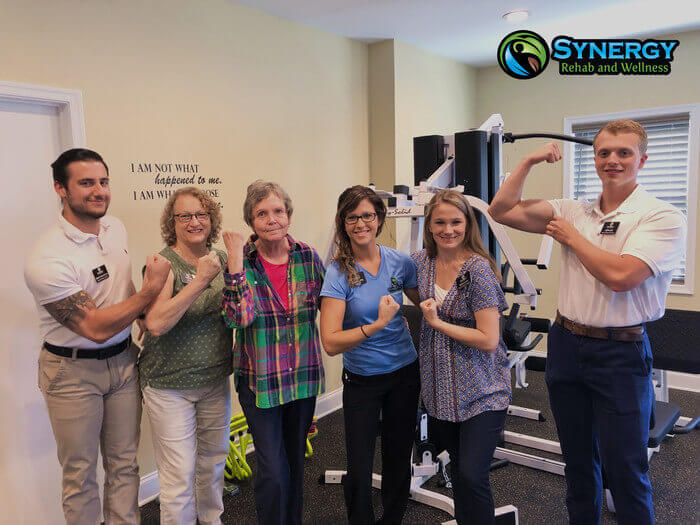Lose the Opioids and Turn to Physical Therapy!
Do you rely on drugs such as oxycodone or hydrocodone to help you get through your day without agonizing pain? Do you worry that these drugs may be placing your health at unacceptable risk? Do you feel anxious or count the minutes until your next dosage of these pain relievers regardless of that risk?
If so, you may be on the threshold of opioid dependence – a dangerous, potentially deadly situation. The good news is that you can get away from those opioid drugs without falling into the grip of unmanageable pain, thanks to the benefits provided by physical therapy.
Our innovative care strategies at Synergy Rehab & Wellness will help you find quick relief. Before you take another pill for your pain, call our office to schedule an appointment with a physical therapist. We want you to know that relief from arthritis pain is possible with the help of physical therapy.
Physical therapy can help you govern your pain without drugs, giving you a chance to break away from your reliance on opioids.
Contact our physical therapist to get started on this safe, healthy, drug-free approach to pain management!
What should I know about opioids?
Opioids are strong pain killing drugs that are often prescribed to combat severe chronic pain. They are traditionally derived from substances in the poppy plant.
Opioids such as morphine, codeine, hydrocodone, and oxycodone can often deaden pain when milder drugs cannot, making them a common prescription for cancer pain, acute injuries, and severe neurological or musculoskeletal pain. They can also produce euphoria or unconsciousness, making them a highly-abused substance in both legal and illegal forms (such as heroin).
Opioids work by binding to opioid receptors in the brain and other structures of the body. As the opioids occupy these receptors, they prevent the receptors from receiving pain signals. At the same time, the opioids trigger the release of large amounts of dopamine, a substance that evokes feelings of pleasure.
Understanding the dangers of opioids
Unfortunately, the painkilling and pleasurable benefits of opioids come at a frighteningly high price. The simple fact that these drugs are so effective at making you feel good creates a compulsion to keep using them.
At the same time, the body builds up an ever-increasing tolerance to the drugs, requiring larger and larger dosages to achieve the same effects.
This cycle can lead to a strong, dangerous level of addiction. It’s little wonder, then, that more than 11 million Americans abuse opioids. Eventually, escalating tolerance can force users to take a fatal dose. Two-thirds of all overdose-related deaths in the U.S. are related to some form of opioid.
The benefits of physical therapy
You have good reason to fear opioid dependence – and equally good reason to seek out physical therapy as a non-toxic alternative to drugs.
Our physical therapist can prescribe a personalized mix of treatment methods that loosen tight muscles, help joints move more freely, build up muscle strength, reduce inflammation, and help tame neurological problems such as herniated discs and pinched nerves.
You should consider physical therapy if:
- You’re experiencing issues such as addiction, depression, or physical side effects from opioid usage – or you’re determined to avoid such issues
- You suffer from a chronic, incurable pain condition that might otherwise require a lifetime on opioids
- Your pain is musculoskeletal or neuromuscular in origin (as opposed to cancer pain, for instance)
- You’re interested in actually treating the underlying cause of the pain, instead of simply numbing the pain itself
Physical therapy can help you get a handle on your pain so that you don’t need opioids anymore. Of course, you should only discontinue high doses of opioids under professional medical supervision (to prevent a potentially dangerous withdrawal).
In the meantime, however, our physical therapist can work with you on treating the biomechanical problems that caused your pain in the first place.
Here are just a few of the physical therapy modalities that can help you conquer your pain:
- Transcutaneous electrical nerve stimulation (TENS) uses electrical energy to block pain signals to nerves.
- Laser therapy can ease pain caused by injuries, arthritis, muscular strain, tendinitis, or neuropathy.
- Massage therapy can control painful muscle spasms, help the tissues expel inflammatory substances, and direct more blood and oxygen to an injury.
- Exercises can increase your pain-free range of motion, strengthen the muscles that support your body, and increase blood flow to reduce inflammation.
Rid yourself of harmful opioids today:
Even if your pain cannot be fully relieved through physical therapy, our physical therapist’s methods may still ease your symptoms to the point that you can get by with minimal dosages.
But be aware that if you’re currently dependent on opioids, your doctor must supervise any reduction in dosage for your own safety.
You don’t have to place yourself in the grip of opioid dependence. Talk to our physical therapist about your non-pharmaceutical treatment options!


